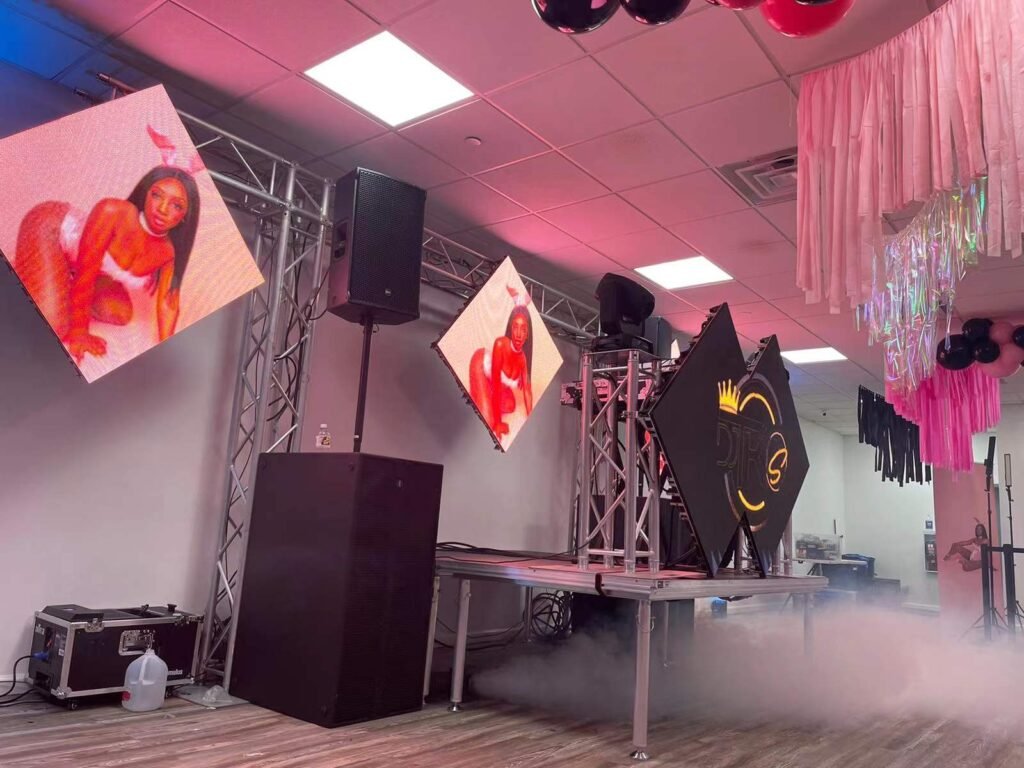In various performances and events, stage rental LED displays have become a key element in creating stunning visual effects. Efficient and flexible LED display screens can meet the needs of different stage scenes and add luster to performances.

1)Screen selection
Indoor scene: If the audience is watching at a close distance, such as a theater, conference room, etc., it is recommended to use products with small pixel spacing, such as P2.5 and below specifications, which can present extremely delicate images.
Outdoor scenes or large venues: If the audience has a long viewing distance, products with a pixel spacing of P4-P8 can be considered. Taking music festivals and large-scale concerts as examples, these spacing products have high brightness and wide viewing angles, ensuring that the rear audience can also clearly see the screen content.
2)Box design considerations
Lightweight and structurally strong: The use of die cast aluminum material for the box body, such as the common 500mm × 500mm and 500mm × 1000mm specifications, results in a lightweight individual box body that is easy to transport by a single person. During the rapid construction and dismantling process of the stage, it can greatly save labor costs; And the die-casting aluminum material has high strength and good toughness, and is not easily deformed during frequent handling, ensuring the stability of long-term rental use.
Splicing accuracy and flexibility: High precision processing technology ensures that the box size tolerance is less than 0.2mm, ensuring seamless splicing and natural and smooth transition of the image; Some models support staggered splicing, and the side of the box is equipped with a curved scale edge lock design, which can splice any curvature from -15 degrees to 15 degrees, facilitating the creation of diverse stage shapes such as inner arc, outer arc, right angle, etc., meeting the needs of creative performances.

3)Protection level requirements
Outdoor use: Outdoor performances are susceptible to wind and rain, and display screens with a protection level of IP65 or higher should be selected. This level means that the display screen can effectively prevent water and dust, and can work normally even in light rain or sandstorm environments, protecting internal electronic components from damage and ensuring smooth performance.
Indoor special environment: If the indoor humidity is high or there is a lot of dust, such as in some industrial themed performance venues, it is also recommended to choose a display screen with certain protective capabilities, such as IP40 protection level, which can prevent large particles of dust from entering and extend the service life of the display screen.
4)Installation method selection
Lifting: Suitable for places with high ceiling spaces such as theaters and auditoriums. By using professional lifting equipment to hang the LED display screen above the stage, it can save ground space, create a suspended visual effect, and enhance the three-dimensional sense of the stage; At the same time, it can provide the audience with a better viewing angle, especially suitable for displaying panoramic images or important close-up shots.
Stacking: commonly used for outdoor large-scale performances such as music festivals and concerts. Stacking and installing display screen enclosures on the ground in front of the stage is relatively simple, and the height and angle can be flexibly adjusted according to the stage terrain to enhance screen stability and ensure stable display of images even in crowded and lively environments.

Installation of Japanese scaffolding: For situations where space is limited and ground conditions are complex, installation of Japanese scaffolding is a good choice. By using the Japanese frame as a support structure, it is possible to quickly build a display screen, and the Japanese frame can be reused, saving labor and material costs, and also facilitating maintenance personnel to inspect the display screen in the later stage.




